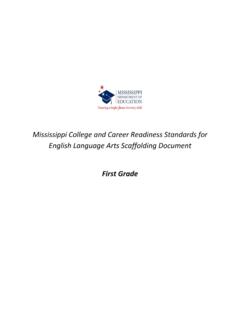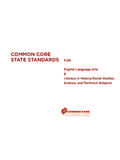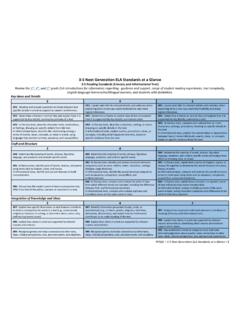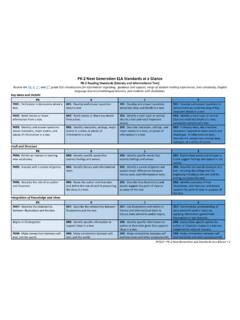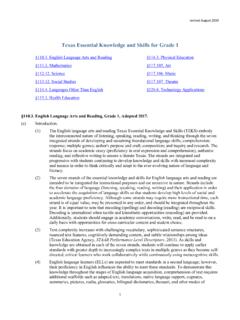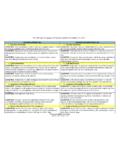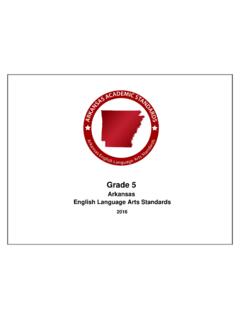Transcription of TEKS Snapshot – Grade 6 Reading - SAISD
1 TEKS Snapshot Grade 6 Reading (A) is used consistently when there is a SE connected to a K&S Source: Texas Education Agency v. Reading /Comprehension Skills Figure 19 Reading /Comprehension Skills. Students use a flexible range of metacognitive Reading skills in both assigned and independent Reading to understand an author s message. Students will continue to apply earlier standards with greater depth in increasingly more complex texts as they become self-directed, critical readers. Reading /Fluency. Students read Grade -level text with fluency and comprehension.
2 Reading /Vocabulary Development. Students understand new vocabulary and use it when Reading and writing. Tools to Know-Process Tools to Know-Comprehension (A) (B) 6 (A) 6 (B) 6 (C) 6 (D) 6 (E) 6 (F) read aloud Grade -level appropriate text with fluency (rate, accuracy, expression, appropriate phrasing) and comprehension use context ( , cause and effect or compare and contrast organizational text structures) to determine or clarify the meaning of unfamiliar or multiple meaning words establish purposes for Reading selected texts based upon own or others desired outcome to enhance comprehension ask literal, interpretive, evaluative, and universal questions of text monitor and adjust comprehension ( , using background knowledge; creating sensory images; rereading a portion aloud.)
3 Generating questions) make inferences about text and use textual evidence to support understanding summarize, paraphrase, and synthesize texts in ways that maintain meaning and logical order within a text and across texts make connections ( , thematic links, author analysis) between and across multiple texts of various genres, and provide textual evidence Knowledge and Skills (Genres) Reading /Comprehension of literary Text/Fiction. Students understand, make inferences and draw conclusions about the structure and elements of fiction and provide evidence from text to support their understanding.
4 Reading /Comprehension of literary Text/Poetry. Students understand, make inferences and draw conclusions about the structure and elements of poetry and provide evidence from text to support their understanding. Reading /Comprehension of literary Text/Drama. Students understand, make inferences and draw conclusions about the structure and elements of drama and provide evidence from text to support their understanding. Reading /Comprehension of literary Text/ literary Nonfiction. Students understand, make inferences and draw conclusions about the varied structural patterns and features of literary nonfiction and provide evidence from text to support their understanding.
5 Reading /Comprehension of informational Text/Expository Text. Students analyze, make inferences and draw conclusions about expository text and provide evidence from text to support their understanding. Reading /Comprehension of informational Text/Persuasive Text. Students analyze, make inferences and draw conclusions about persuasive text and provide evidence from text to support their analysis. Knowledge and Skills (Embedded or Across Genres) Reading /Vocabulary Development. Students understand new vocabulary and use it when Reading and writing.
6 Reading /Comprehension of literary Text/Theme and Genre. Students analyze, make inferences and draw conclusions about theme and genre in different cultural, historical, and contemporary contexts and provide evidence from the text to support their understanding. Reading /Comprehension of literary Text/Sensory Language. Students understand, make inferences and draw conclusions about how an author's sensory language creates imagery in literary text and provide evidence from text to support their understanding Reading /Comprehension of informational Text/Culture and History.
7 Students analyze, make inferences and draw conclusions about the author's purpose in cultural, historical, and contemporary contexts and provide evidence from the text to support their understanding. Reading /Comprehension of informational Text/Procedural Texts. Students understand how to glean and use information in procedural texts and documents. Reading /Media Literacy. Students use comprehension skills to analyze how words, images, graphics, and sounds work together in various forms to impact meaning. Students will continue to apply earlier standards with greater depth in increasingly more complex texts TEKS Snapshot Grade 6 Reading (A) is used consistently when there is a SE connected to a K&S Source: Texas Education Agency v.
8 Rptg Cat STAAR Genre Readiness Standards Supporting Standards Figure 19 1 Understanding and Analysis Across Genres 8 Across Genres (A) determine the meaning of Grade -level academic English words derived from Latin, Greek, or other linguistic roots and affixes (B) use context ( , cause and effect or compare and contrast organizational text structures) to determine or clarify the meaning of unfamiliar or multiple meaning words (E) use a dictionary, a glossary, or a thesaurus (printed or electronic) to determine the meanings, syllabication, pronunciations, alternate word choices, and parts of speech of words (C) compare and contrast the historical and cultural settings of two literary works (A) identify the literary language and devices used in memoirs and personal narratives and compare their characteristics with those of an autobiography (A) compare and contrast the stated or implied purposes of different authors writing on the same topic (A)
9 Compare and contrast the structure and viewpoints of two different authors writing for the same purpose, noting the stated claim and supporting evidence 6 (F) Identified as (F) on TEA Student Expectations Tested report SEs Not Included in Assessed Curriculum (C) complete analogies that describe part to whole or whole to part ( , ink:pen as page: ____ or pen:ink as book: _____) (D) explain the meaning of foreign words and phrases commonly used in written English ( , RSVP, que sera sera) 2 Understanding and Analysis of literary Texts 17 Fiction (A) summarize the elements of plot development ( , rising action, turning point, climax, falling action, denouement) in various works of fiction (A) infer the implicit theme of a work of fiction, distinguishing theme from the topic (B) recognize dialect and conversational voice and explain how authors use dialect to convey character (C)
10 Describe different forms of point-of-view, including first- and third-person (D) (E) Poetry (A) explain how figurative language ( , personification, metaphors, similes, hyperbole) contributes to the meaning of a poem (D) (E) Drama Students understand, make inferences and draw conclusions about the structure and elements of drama and provide evidence from text to support their understanding. (D) (E) SEs Not Included in Assessed Curriculum (A) explain the similarities and differences in the setting, characters, and plot of a play and those in a film based upon the same story line literary Nonfiction See (A) in Reporting Category 1 (D) (E) Across literary Text Across literary Text (A) explain how authors create meaning through stylistic elements and figurative language emphasizing the use of personification, hyperbole, and refrains (B)


